Indoor vs Outdoor Pickleballs - Find Your Perfect Match!
Discover the key differences between indoor and outdoor pickleballs to choose the right one for your game. Elevate your skills with the perfect match!
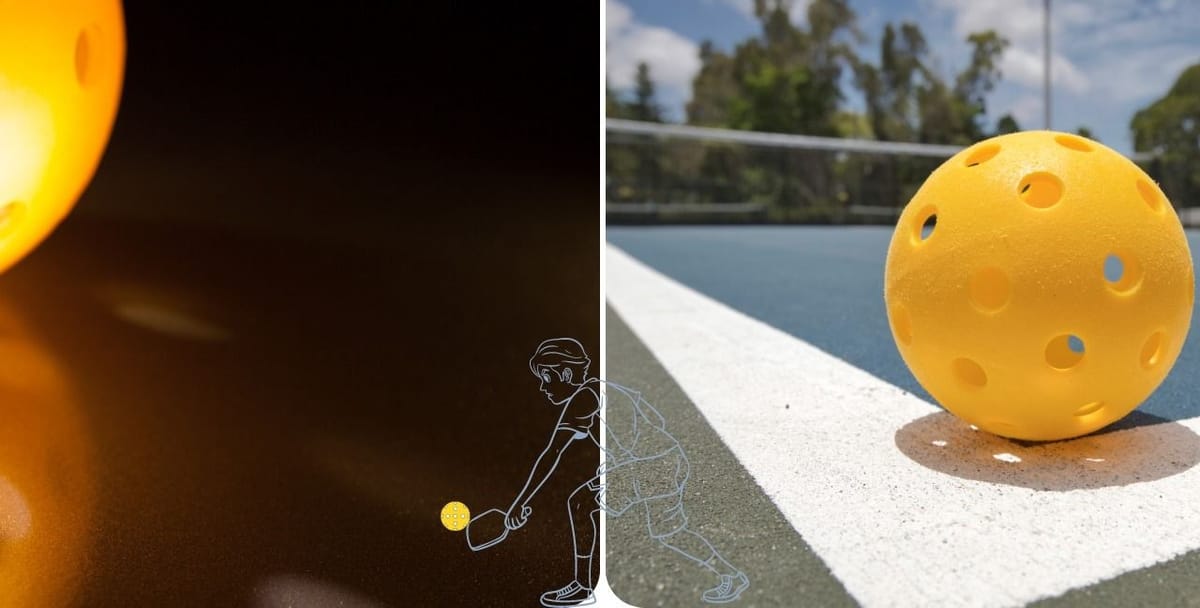
Attention pickleball enthusiasts! Are you ready to embark on an adventure that'll have you bouncing with excitement?
Today, we're diving headfirst into the epic showdown of indoor vs outdoor pickleball! It's the ultimate clash of the bounces, where two seemingly similar balls reveal their unique personalities on different terrains.
At first glance, pickleball may seem akin to Wiffle balls, but don't be fooled! These little globes of fun come in a variety of options, each unique in its own way. The key to distinguishing them lies in the number and size of their holes, with indoor boasting 26 larger holes, while outdoor flaunting 40 smaller ones.
The choice between indoor and outdoor pickleball is no trivial matter, as climate and court surface impact weight, hardness, texture, and durability. Whether you're a seasoned player or a newbie, understanding the five major differences between indoor and outdoor pickleball will be your ticket to mastering the game like a pro!
How Do You Tell the Difference between Indoor and Outdoor Pickleballs?
Telling the difference between indoor and outdoor pickleball is crucial for optimizing your gameplay. Indoor pickleballs typically have larger holes and a softer feel, suitable for smooth indoor surfaces.
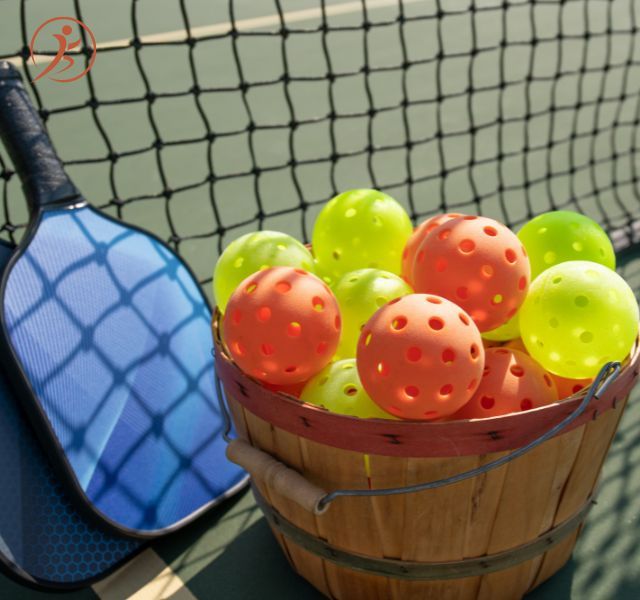
On the other hand, outdoor pickleballs have smaller holes and are more durable to withstand rougher outdoor courts and varying weather conditions. By understanding these distinctions, you can choose the right pickleball for your preferred playing environment and elevate your pickleball experience to new heights.
In summary, pickleball is a unique and exciting sport with a rich history that originated as a fun family activity and has evolved into a beloved pastime worldwide. Its combination of accessibility, camaraderie, and engaging gameplay makes it a favorite among players of all ages and abilities.
Unraveling the Distinction: Indoor vs. Outdoor Pickleballs?
At first glance, indoor and outdoor pickleball might seem like peas in a pod, but the moment you cradle them in your hands or place them side by side, their disparities come into sharp focus. Let's delve into the intriguing world of pickleball and uncover the noticeable contrasts between the indoor and outdoor variants.
Of course, there are exceptions, but in general, the majority of indoor and outdoor balls are unique in the following ways:
Difference # 1: Number of Holes
An indoor pickleball typically has 26 holes, while an outdoor pickleball usually has 40 holes. The difference in the number of holes contributes to their distinct characteristics, with indoor pickleball having larger holes for a softer bounce suited to indoor surfaces, and outdoor pickleball having more holes for better wind resistance and durability on outdoor courts.
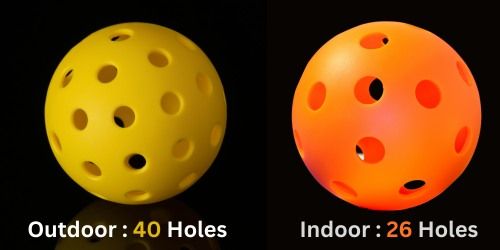
Difference # 1: Hole Diameter
The holes in an indoor pickleball are generally larger and measure around 0.43 inches in diameter. On the other hand, the holes in an outdoor pickleball are slightly smaller, measuring approximately 0.282 inches in diameter. These size differences in the holes contribute to the unique playing characteristics of each type of pickleball, with indoor balls offering softer and slower play, while outdoor balls provide better durability and performance in windy conditions.
Outdoor .282" Hole Size / Indoor .43" Hole Size
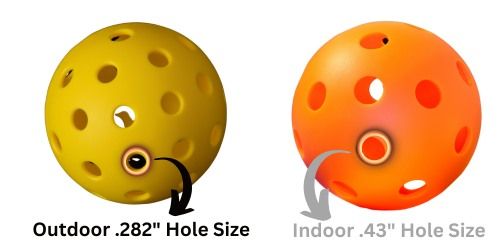
Difference # 3: Weight
Outdoor balls tend to be heavier than indoor balls.
outdoor weight 0.925 ounces / indoor weight 0.917 ounces
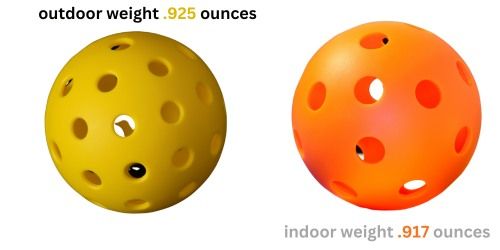
Difference # 4: Hardness
Pickleballs are made of plastic. Pickleball was measured using a scientific way of grading the hardness with the Durometer hardness test.
Pickleball is manufactured using plastics and hard rubbers with a range of typical hardness.
Material
- Low-Density Polyethylene: 40-50
- High-Density Polyethylene: 60-70
- Polypropylene: 70-83
- Polyethylene Terephthalate: 85-95
In general, balls made of thermoplastic rubber are going to be far spongier than a ball made with High-Density Polyethylene. The hardness of a pickleball determines its performance.
Difference # 5: Durability
Because outdoor pickleballs are harder they tend to crack quicker than softer indoor pickleballs.
While each brand and type of pickleball has several specifications to make it unique, USA Pickleball has created metrics for getting a pickleball approved by its governing body.
Summary
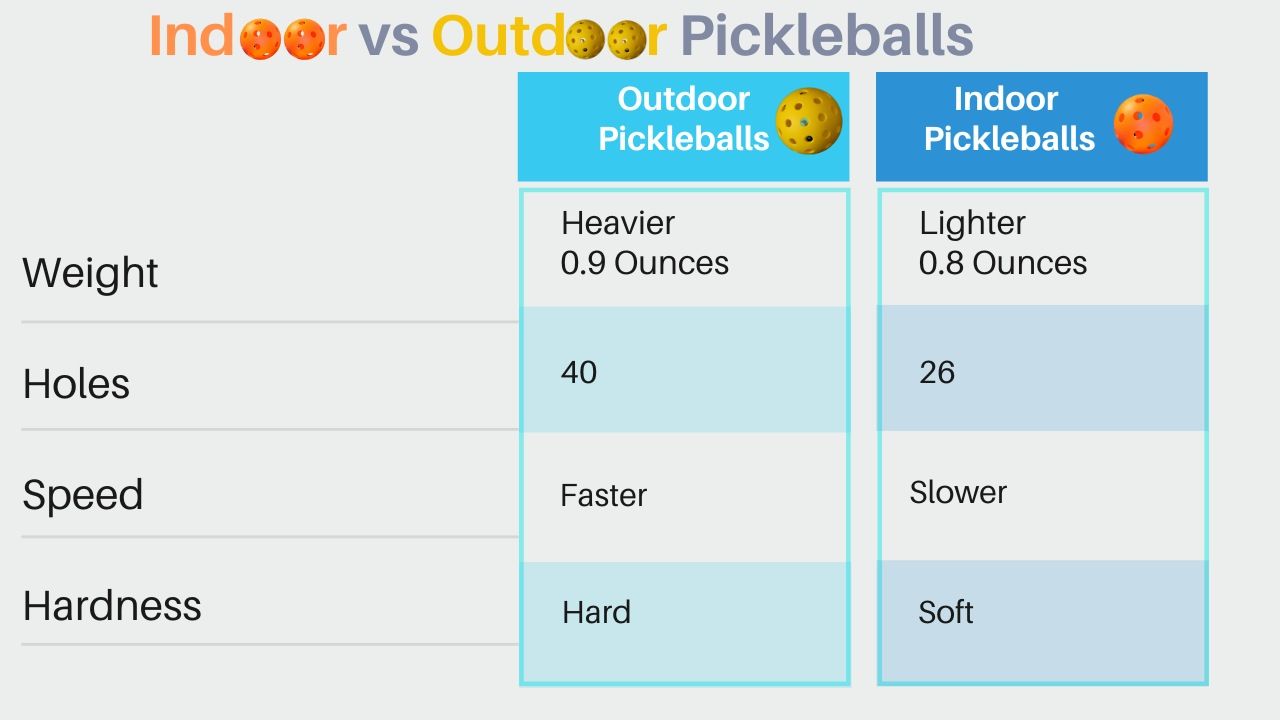
Why Do Indoor Pickleballs Have Larger Holes?
Ah, the mysterious world of pickleball holes! It's a curious sight to behold, but fear not, dear pickleball enthusiasts, for we have the answer to this peculiar phenomenon. Indoor pickleballs flaunt larger holes compared to their outdoor counterparts for a reason – it's all about taming the speed demon!
The larger holes create more air resistance, which slows down the ball's flight indoors. This makes the game more controllable and allows players to showcase their finesse and precision.
So, the next time you're on the indoor court, marvel at those big holes and remember that they're the secret behind the game's grace and finesse. Now, let's keep exploring the fascinating world of indoor vs outdoor pickleball!
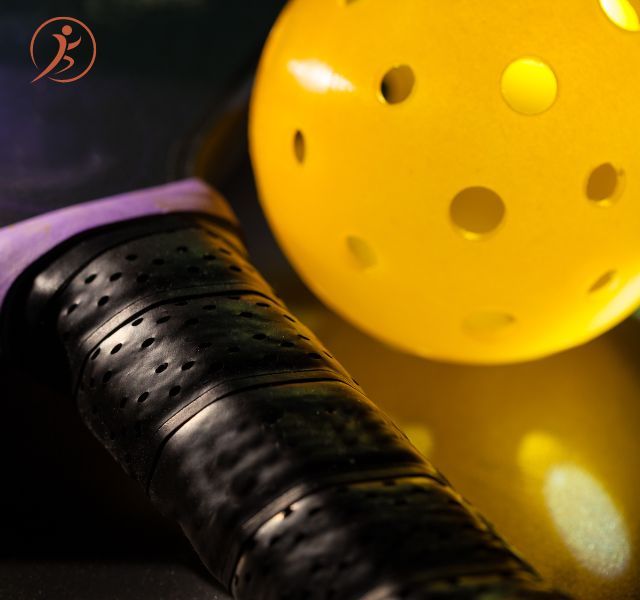
Benefits of Indoor Pickleball
Using indoor pickleball comes with a host of benefits that can elevate your game and add an extra bounce to your step on the court! Firstly, the larger holes on indoor pickleballs create more air resistance, making them ideal for indoor play. This leads to a slower pace, allowing players to enjoy longer rallies and showcase their strategic prowess.
Indoor pickleballs also tend to have a softer construction, which makes them gentler on the paddles and reduces the risk of wear and tear during intense games. This durability factor ensures that your beloved pickleball remains in top-notch condition for a longer time, sparing you from frequent replacements.
Can Indoor Pickleballs be Used on Outdoor Pickleball Courts?
While indoor pickleball is primarily designed for use on smooth indoor surfaces, it can also be used on outdoor pickleball courts with some limitations. However, there are a few factors to consider before making the switch:
- Durability: Indoor pickleballs are generally softer and have larger holes, which can make them more susceptible to damage when used on rough outdoor surfaces. They may wear out faster and may not withstand the elements as well as outdoor pickleballs.
- Ball Bounce: The slower pace and softer construction of indoor pickleball may not perform optimally on outdoor courts, which often require a faster ball with more bounce to suit the rougher surface. Outdoor pickleballs are designed for better durability and consistent bounce on outdoor courts.
- Wind Resistance: Indoor pickleball may be more affected by wind due to their larger holes and lighter weight, making it challenging to control the ball's trajectory on outdoor courts.
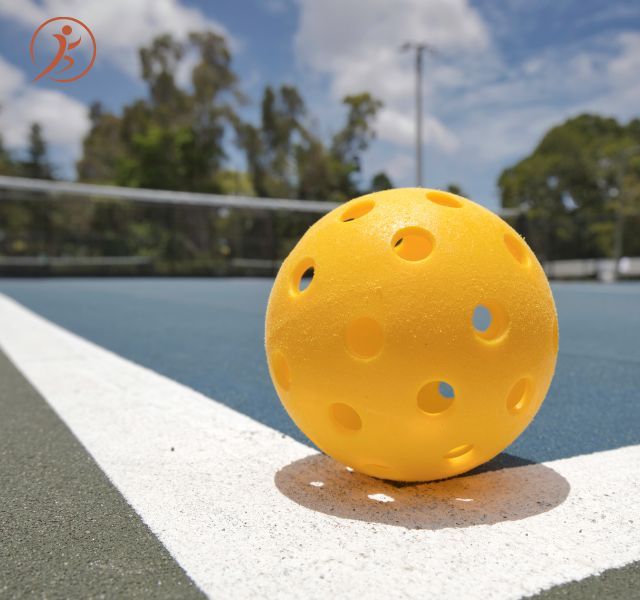
In some casual or recreational settings, players may use indoor pickleball on outdoor courts if no outdoor balls are available. However, for competitive play and to ensure the best performance, it is recommended to use outdoor pickleball specifically designed for outdoor courts. They provide better durability, consistent bounce, and improved playability, making them the preferred choice for outdoor pickleball courts.
Official USA Pickleball Ball Guidelines
- Approved Balls: The USAPA has approved specific brands and models of pickleballs for tournament and sanctioned play. Currently, the approved balls include the Dura Fast 40, Onix Fuse G2, and the Franklin X-40. These balls have been tested and meet the required standards for size, weight, bounce, and overall performance.
- Size and Weight: Official pickleball balls must have a diameter of 2.874 inches to 2.972 inches (73mm to 75.5mm) and weigh between 0.78 ounces to 0.935 ounces (22g to 26.5g). This standard ensures uniformity and consistency in the game.
- Color: Pickleballs used in official play are typically yellow or white. Yellow balls are commonly used for indoor play, while white balls are preferred for outdoor play to enhance visibility against different backgrounds.
- Bounce: The official balls must have a consistent bounce height when dropped from a specified height. This ensures fairness and predictability in the game.
- Packaging: Official pickleball balls are usually sold in packs of 3 or 6, and the packaging often displays the USAPA approval seal.
Please note that the guidelines may be subject to updates, and it is essential to refer to the USAPA website or official pickleball tournament rules for the most current information on approved balls and guidelines.
How Do You Find the Right Pickleball?
- Understand the Different Types: There are indoor and outdoor pickleballs, each designed for specific playing environments. Indoor balls are typically softer and have larger holes, while outdoor balls are more durable and have smaller holes to withstand rough surfaces like concrete.
- Consider Skill Level: Different pickleballs may be better suited for various skill levels. Beginners might prefer a softer ball that is easier to control, while more advanced players may opt for a faster, harder ball that allows for more spin and power.
- Customer Feedback: Customer feedback is a valuable way to see how other players rate the pickleball.
- Try Different Brands: If possible, try out different brands and models of pickleball to see which one feels the most comfortable for your playing style. Many pickleball facilities or clubs offer loaner balls or have different types available for purchase.
- Ask for Recommendations: Seek advice from experienced pickleball players or coaches. They may have valuable insights into which pickleball is best suited for your skill level and playing preferences.
- Consider Tournament Requirements: If you plan to play in tournaments or sanctioned events, make sure to check the official ball guidelines set by organizations like USA Pickleball (USAPA). Ensure that the pickleball you choose is approved for tournament play.
- Personal Preference: Ultimately, the best pickleball for you will come down to personal preference. Consider factors such as ball color, visibility, and feel when hitting the ball. Some players may prefer a softer ball for better control, while others may prefer a harder ball for more power.
Indoor Vs Outdoor Pickleball
FAQs
Q: How to tell the difference between indoor and outdoor pickleball balls?
Answer: To tell the difference between indoor and outdoor pickleball balls, you can look for the following characteristics:
- Color: Indoor pickleball balls are typically bright yellow, while outdoor balls are often orange or a similar bright color. This color difference helps players quickly identify the appropriate ball for the playing environment.
- Hole Pattern: Check the hole pattern of the ball. Indoor pickleball balls usually have larger holes compared to outdoor balls. The larger holes on indoor balls create more air resistance, making them slower and better suited for indoor play.
- Texture: Outdoor pickleball balls are often designed with a more durable and rugged texture to withstand the rough surfaces of outdoor courts. They may have a slightly rougher surface compared to indoor balls.
- Bounce: Indoor balls tend to have a slightly softer feel and lower bounce compared to outdoor balls. Outdoor balls are designed for hard outdoor surfaces, so they usually have a livelier bounce.
- Material: Indoor and outdoor balls may be made of different materials to cater to their respective playing environments. Outdoor balls are typically more durable to handle the wear and tear of outdoor play.
- Packaging: Check the packaging or labeling of the pickleball balls. Manufacturers often specify whether the balls are designed for indoor or outdoor play.
- Certification: Look for the USA Pickleball (USAPA) approval stamp on the ball. USAPA-approved balls meet the size, weight, and performance standards for tournament play, regardless of whether they are meant for indoor or outdoor use.
Remember that using the right type of pickleball for the appropriate playing environment is essential for maintaining the integrity of the game and ensuring fair and enjoyable play for all participants.
Q: Can indoor pickleball be used outdoors?
Answer: Yes, indoor pickleballs can be used outdoors, but they may not perform optimally on outdoor courts. Indoor pickleballs are designed with larger holes and a softer construction to adapt to indoor playing conditions, such as lower ceiling heights and smoother surfaces. When used on outdoor courts, these balls may not bounce as well and may be more susceptible to damage due to the rougher outdoor surfaces.
While using indoor pickleball outdoors is possible, it is generally recommended to use outdoor-specific pickleball for outdoor play. Outdoor pickleballs are designed to withstand the harsher conditions of outdoor courts, such as rougher surfaces, higher temperatures, and increased wind resistance. They have a more durable construction and a livelier bounce, making them better suited for outdoor play.
Using the appropriate type of pickleball for the specific playing environment will ensure a better game experience and help preserve the longevity of the balls.
Q: Why are there indoor and outdoor pickleballs?
Answer: Indoor and outdoor pickleball are designed differently to accommodate the distinct playing conditions and surfaces of each environment.
Indoor Pickleballs
- Larger Holes: Indoor pickleballs have larger holes, making them lighter and slower. This allows for better control and slower gameplay, suitable for indoor courts with lower ceilings and limited space.
- Softer Construction: Indoor pickleballs are softer to prevent excessive noise and potential damage to indoor surfaces like wooden or composite floors.
- Controlled Bounce: The slower bounce of indoor pickleball is ideal for the confined spaces of indoor courts, allowing players to engage in more strategic play.
Outdoor Pickleballs
- Smaller Holes: Outdoor pickleball have smaller holes, making them more aerodynamic and better able to withstand outdoor elements like the wind.
- Durable Construction: Outdoor pickleballs are made with more durable materials to withstand the wear and tear of rough outdoor surfaces like concrete or asphalt.
- Livelier Bounce: Outdoor pickleballs have a livelier bounce, which compensates for the impact of outdoor surfaces and provides a faster-paced game.
By tailoring pickleball to their respective environments, players can enjoy a more engaging and optimized experience on both indoor and outdoor courts.
Q: What is the difference between yellow and orange pickleball?
Answer: The main difference between yellow and orange pickleball is their visibility and usage on different playing surfaces.
Yellow Pickleballs
- Visibility: Yellow pickleball is the most commonly used color and is highly visible indoors and outdoors. The vibrant yellow color makes them easier to track during play, especially against various backgrounds.
- Indoor and Outdoor Use: Yellow pickleballs are suitable for both indoor and outdoor play. Their visibility allows players to use them effectively in various lighting conditions.
Orange Pickleballs
- Enhanced Visibility: Orange pickleballs are designed for better visibility on outdoor courts, especially on bright, sunny days. The orange color stands out well against green outdoor surfaces, making it easier to track the ball during play.
- Outdoor Use: Orange pickleballs are primarily intended for outdoor play due to their enhanced visibility on outdoor courts.
Overall, both yellow and orange pickleball are popular choices for different playing environments. Players can select the color that best suits their preferences and the lighting conditions of their chosen pickleball court.
Key Takeaways!
Indoor pickleballs, with their larger holes and softer construction, are specifically designed for indoor play and offer excellent control and responsiveness on indoor surfaces. On the other hand, outdoor pickleball, often available in bright orange for better visibility, is ideal for outdoor play and can withstand the demands of rougher outdoor courts. While both types serve their respective purposes, it's essential for players to select the appropriate pickleball based on where they'll be playing. Whether you're enjoying the fast-paced action on an indoor court or basking in the sunshine on an outdoor one, the right choice of pickleball can enhance your playing experience and keep the fun rolling!
Pickleball Articles Worth Reading!
- Game On the Go: Unleash the Fun with a Portable Pickleball Net!
- 10 Pickleball Rules You Need to Know to Dominate the Court Like a Pro!
- 4 Must-Have Pickleball Paddles That'll Up Your Game in No Time!
- Game On: Unveiling Pickleball Set That Will Revolutionize Your Playtime!
- Demystifying the Magic of Pickleball Paddle Grips
- Ideas That'll Upgrade Your Home Office Comfort
- Unleash Your Game With The Perfect Pickleball Shoes for Men
Sponsored By

